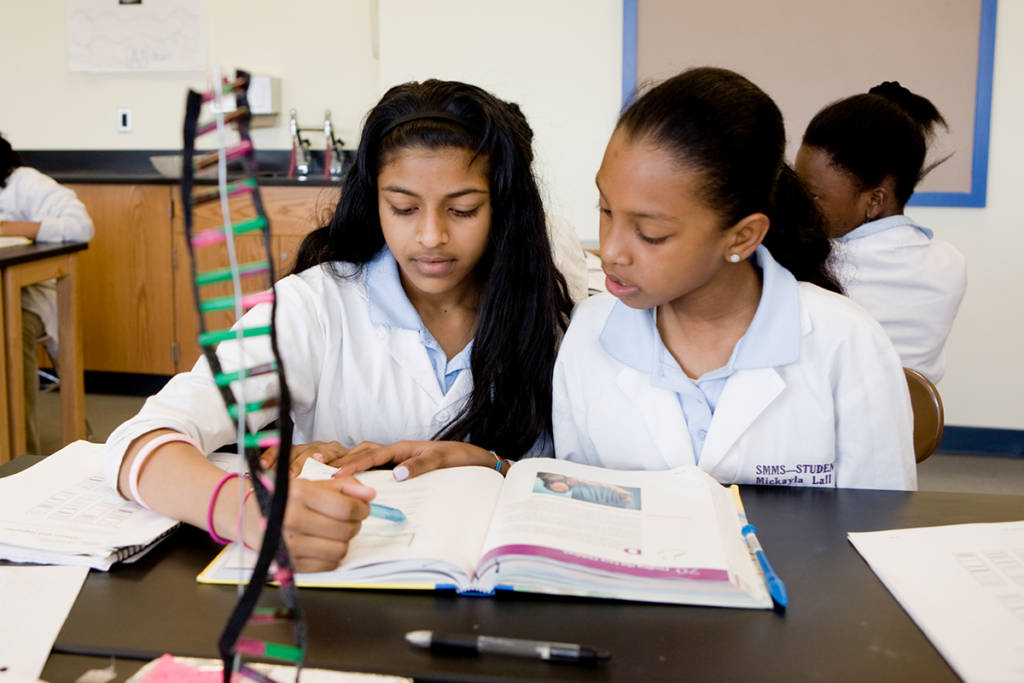Despite significant progress in closing the gender gap in science, technology, engineering and math (also known as STEM), inequities in girls’ and women’s participation and persistence in math and across STEM education and careers remain (GSUSA, 2012; NSF, 2017). According to the U.S. Census Bureau, women make up nearly half of the U.S. workforce but just 26 percent of STEM workers, as of 2011. Within STEM, the largest number of new jobs are in the computer science and math fields; however, the gender gap in these careers has increased rather than decreased, with female representation decreasing since 2000.
Scholarship on the role of non-cognitive factors of academic success suggests that girls’ math identity (i.e., their beliefs, attitudes, emotions, and dispositions about math and their resulting motivation to engage and persist in related activities) is an important, yet neglected and under-researched driver of math participation and persistence (Farrington et al, 2012; Boaler, 2014). Moreover, there is often an incompatibility between the identities modeled in today’s math and science classrooms and the identities girls want for themselves, contributing to lower female participation in STEM compared to that of males.
Boaler & Greeno, 2000, interviewed 48 high school AP calculus students to provide insight into students’ math understanding, as well as their life and career choices. Interviewees were identified from six Northern California high schools and were balanced so that researchers had an equal number of girls and boys, as well as students identified by their AP calculus teacher as confident in math or lacking confidence. As AP calculus students, interviewees can be regarded as successful students, having chosen to take an advanced-level math elective.
Their findings suggest that students – more so with female participants – who could be successful in math fields, decided to leave or disengaged with math because they did not want to be perceived as passive recipients of knowledge but rather as constructors of knowledge centered around the need to be creative, use expression, and/or make decisions. This was particularly the case for students whose instruction was mainly teacher-led and focused on procedural knowledge, compared to those classes where students were active agents in their classes, contributing to discussions of questions and a shared understanding of ideas.
Preliminary findings from these studies suggest that (1) supplementary all-girls math classes may be beneficial for certain populations, and all-girls classes in particular may improve achievement for girls of high math ability and identity; (2) math classes or supplemental math activities that are single-sex may increase middle-school students’ sense of belonging regardless of gender; and (3) sense of belonging in girls may have been influenced by the “friend effect”— that is, girls’ reported increased confidence and enjoyment when solving math problems with their friends.
Additionally, we are currently assisting in a four-year project using a cluster-randomized trial to conduct an implementation and impact study examining the effect of math identity-supporting activities from an innovative after-school curriculum on fourth and fifth grade students’ math identity and achievement, particularly for underrepresented groups. Twenty-four after-school programs in South Carolina and 21 programs in New York City are participating. The curriculum, developed by Educational Equity at FHI 360, connects math with art, sports, social justice and music. The curriculum, training, and technical support were offered to both treatment and control sites. Control sites received a version of the curriculum that did not include the specific activities hypothesized to develop math identity (literacy connections, connections to role models, family outreach, and a culminating event where students become experts and share their work in a public exhibit).
While this study is only in its second year, preliminary analysis of student self-perceptions revealed that treatment students were more likely to agree or strongly agree that the activities were fun (66% vs. 53% of students) and were more likely to report that they would like to participate in more math activities (57% vs. 40%).
Photo credit: Jessica Scranton/FHI 360


